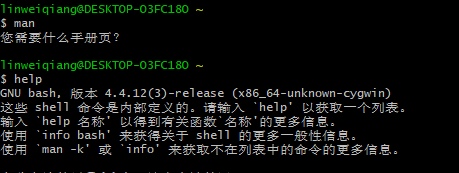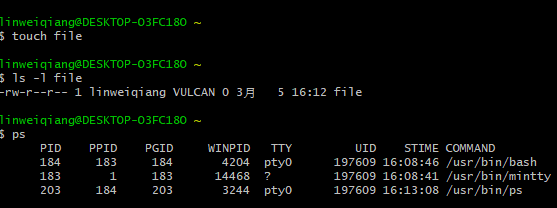OS第1次实验报告:熟悉使用Linux命令和剖析ps命令
- 林伟强
- 201821121010
- 计算1811
1. 实验环境介绍
- 操作系统: Windows10
- 平台:Cygwin
- 用户名:linweiqiang:
![]()
2. 常用命令使用
举例如下:


3. 剖析ps命令
(1)ps使用方法以及参数:
SYNOPSIS
ps [−aA] [−defl] [−g grouplist] [−G grouplist]
[−n namelist] [−o format]... [−p proclist] [−t termlist]
[−u userlist] [−U userlist]
The following options shall be supported:
−a Write information for all processes associated with termi‐
nals. Implementations may omit session leaders from this
list.
−A Write information for all processes.
−d Write information for all processes, except session leaders.
−e Write information for all processes. (Equivalent to −A.)
−f Generate a full listing. (See the STDOUT section for the
contents of a full listing.)
−g grouplist
Write information for processes whose session leaders are given
in grouplist. The application shall ensure that the grouplist is
a single argument in the form of a <blank> or <comma>-separated
list.
−G grouplist
Write information for processes whose real group ID numbers are
given in grouplist. The application shall ensure that the grou‐
plist is a single argument in the form of a <blank> or
<comma>-separated list.
−l Generate a long listing. (See STDOUT for the contents of a long
listing.)
−n namelist
Specify the name of an alternative system namelist file in place
of the default. The name of the default file and the format of a
namelist file are unspecified.
−o format Write information according to the format specification given in
format. This is fully described in the STDOUT section. Multiple
−o options can be specified; the format specification shall be
interpreted as the <space>-separated concatenation of all the
format option-arguments.
−p proclist
Write information for processes whose process ID numbers are
given in proclist. The application shall ensure that the pro‐
clist is a single argument in the form of a <blank> or
<comma>-separated list.
−t termlist
Write information for processes associated with terminals given
in termlist. The application shall ensure that the termlist is a
single argument in the form of a <blank> or <comma>-separated
list. Terminal identifiers shall be given in an implementation-
defined format. On XSI-conformant systems, they shall be given
in one of two forms: the device's filename (for example, tty04)
or, if the device's filename starts with tty, just the identifier
following the characters tty (for example, "04").
−u userlist
Write information for processes whose user ID numbers or login
names are given in userlist. The application shall ensure that
the userlist is a single argument in the form of a <blank> or
<comma>-separated list. In the listing, the numerical user ID
shall be written unless the −f option is used, in which case the
login name shall be written.
−U userlist
Write information for processes whose real user ID numbers or
login names are given in userlist. The application shall ensure
that the userlist is a single argument in the form of a <blank>
or <comma>-separated list.
(2)运行并解释ps命令参数:
运行命令ps -ef,系统返回结果如下:
$ ps -ef
UID PID PPID TTY STIME COMMAND
linweiqi 206 184 pty0 16:17:00 /usr/bin/ps
linweiqi 184 183 pty0 16:08:46 /usr/bin/bash
linweiqi 183 1 ? 16:08:41 /usr/bin/mintty
linweiqiang@DESKTOP-O3FC18O ~
$ ps -e
PID PPID PGID WINPID TTY UID STIME COMMAND
217 184 217 11020 pty0 197609 16:28:30 /usr/bin/ps
184 183 184 4204 pty0 197609 16:08:46 /usr/bin/bash
183 1 183 14468 ? 197609 16:08:41 /usr/bin/mintty
linweiqiang@DESKTOP-O3FC18O ~
$ ps -f
UID PID PPID TTY STIME COMMAND
linweiqi 218 184 pty0 16:28:39 /usr/bin/ps
linweiqi 184 183 pty0 16:08:46 /usr/bin/bash
linweiqi 183 1 ? 16:08:41 /usr/bin/mintty
-e :表示显示全部进程
-f :表示完整-格式,包括命令行
(3)解释返回结果中的字段:
UID(User ID):用户ID;
PID(Process ID):进程ID;
PPID(Parent process ID):父进程ID;
C:CPU使用的资源百分比;
STIME:系统启动时间;
PGID(Process Group ID):进程组ID号;
TTY(TeleTYpe):终端的次要装置号码;
TIME:使用的CPU时间;
CMD:所下达的指令。
③运行命令ps aux,系统返回结果如下:
linweiqiang@DESKTOP-O3FC18O ~
$ ps aux
PID PPID PGID WINPID TTY UID STIME COMMAND
184 183 184 4204 pty0 197609 16:08:46 /usr/bin/bash
227 184 227 14424 pty0 197609 16:49:12 /usr/bin/ps
183 1 183 14468 ? 197609 16:08:41 /usr/bin/mintty
参数a显示现行终端机下的所有程序,包括其他用户的程序;
参数u以用户为主的格式来显示程序状况;
参数x显示所有程序,不以终端机来区分。
COMMAND:所执行的指令





 浙公网安备 33010602011771号
浙公网安备 33010602011771号